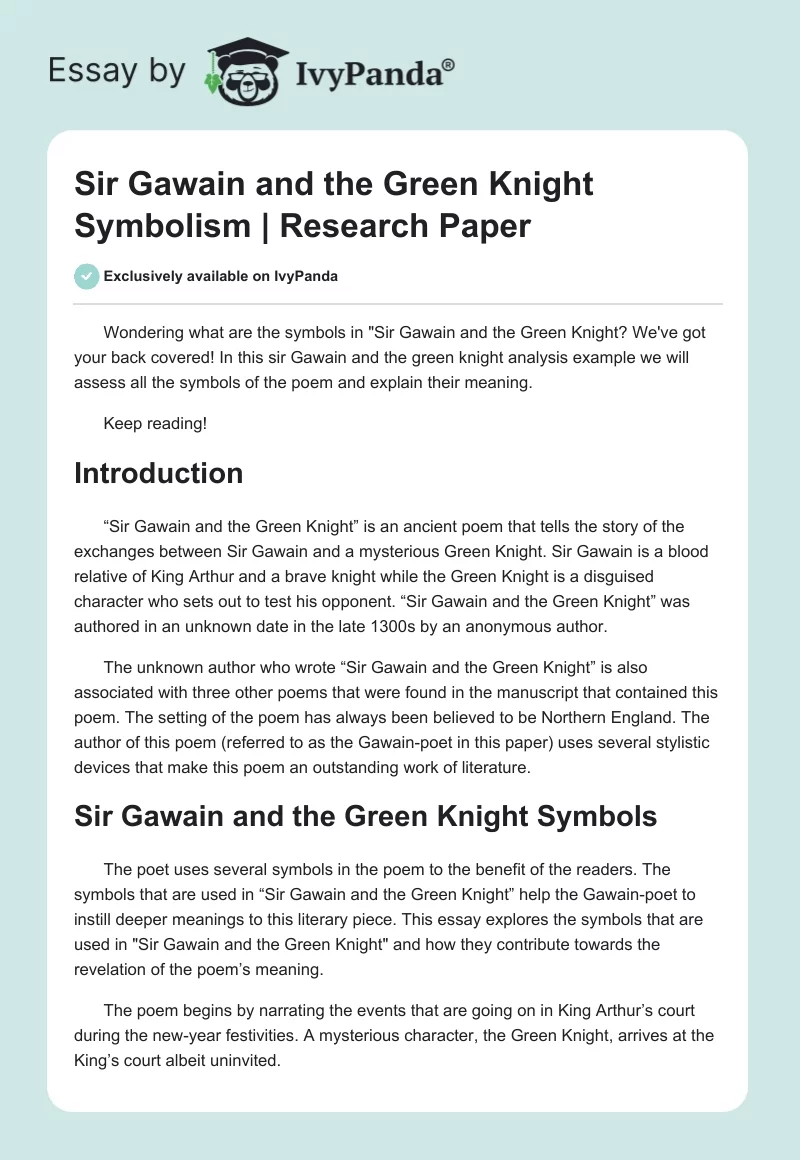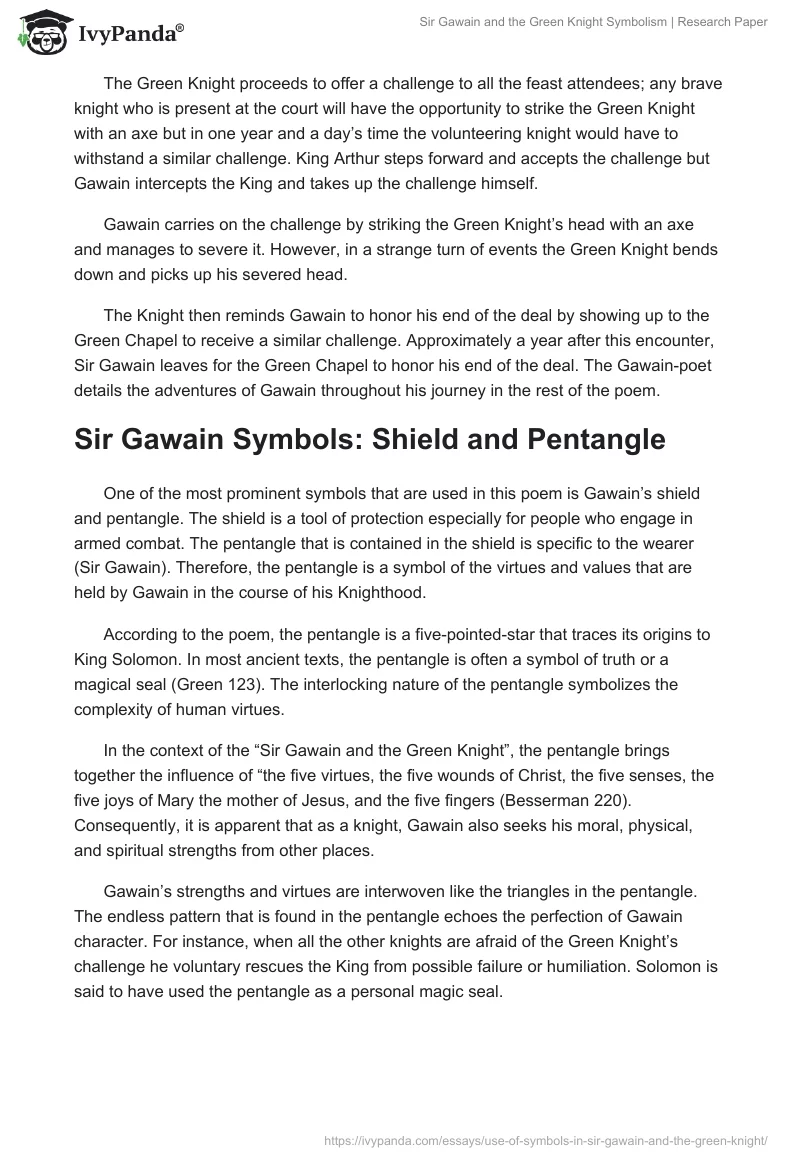Wondering what are the symbols in “Sir Gawain and the Green Knight? We’ve got your back covered! In this sir Gawain and the green knight analysis example we will assess all the symbols of the poem and explain their meaning.
Keep reading!
Introduction
“Sir Gawain and the Green Knight” is an ancient poem that tells the story of the exchanges between Sir Gawain and a mysterious Green Knight. Sir Gawain is a blood relative of King Arthur and a brave knight while the Green Knight is a disguised character who sets out to test his opponent. “Sir Gawain and the Green Knight” was authored in an unknown date in the late 1300s by an anonymous author.
The unknown author who wrote “Sir Gawain and the Green Knight” is also associated with three other poems that were found in the manuscript that contained this poem. The setting of the poem has always been believed to be Northern England. The author of this poem (referred to as the Gawain-poet in this paper) uses several stylistic devices that make this poem an outstanding work of literature.
Sir Gawain and the Green Knight Symbols
The poet uses several symbols in the poem to the benefit of the readers. The symbols that are used in “Sir Gawain and the Green Knight” help the Gawain-poet to instill deeper meanings to this literary piece. This essay explores the symbols that are used in “Sir Gawain and the Green Knight” and how they contribute towards the revelation of the poem’s meaning.
The poem begins by narrating the events that are going on in King Arthur’s court during the new-year festivities. A mysterious character, the Green Knight, arrives at the King’s court albeit uninvited.
The Green Knight proceeds to offer a challenge to all the feast attendees; any brave knight who is present at the court will have the opportunity to strike the Green Knight with an axe but in one year and a day’s time the volunteering knight would have to withstand a similar challenge. King Arthur steps forward and accepts the challenge but Gawain intercepts the King and takes up the challenge himself.
Gawain carries on the challenge by striking the Green Knight’s head with an axe and manages to severe it. However, in a strange turn of events the Green Knight bends down and picks up his severed head.
The Knight then reminds Gawain to honor his end of the deal by showing up to the Green Chapel to receive a similar challenge. Approximately a year after this encounter, Sir Gawain leaves for the Green Chapel to honor his end of the deal. The Gawain-poet details the adventures of Gawain throughout his journey in the rest of the poem.
Sir Gawain Symbols: Shield and Pentangle
One of the most prominent symbols that are used in this poem is Gawain’s shield and pentangle. The shield is a tool of protection especially for people who engage in armed combat. The pentangle that is contained in the shield is specific to the wearer (Sir Gawain). Therefore, the pentangle is a symbol of the virtues and values that are held by Gawain in the course of his Knighthood.
According to the poem, the pentangle is a five-pointed-star that traces its origins to King Solomon. In most ancient texts, the pentangle is often a symbol of truth or a magical seal (Green 123). The interlocking nature of the pentangle symbolizes the complexity of human virtues.
In the context of the “Sir Gawain and the Green Knight”, the pentangle brings together the influence of “the five virtues, the five wounds of Christ, the five senses, the five joys of Mary the mother of Jesus, and the five fingers (Besserman 220). Consequently, it is apparent that as a knight, Gawain also seeks his moral, physical, and spiritual strengths from other places.
Gawain’s strengths and virtues are interwoven like the triangles in the pentangle. The endless pattern that is found in the pentangle echoes the perfection of Gawain character. For instance, when all the other knights are afraid of the Green Knight’s challenge he voluntary rescues the King from possible failure or humiliation. Solomon is said to have used the pentangle as a personal magic seal.
Solomon and Gawain: Similarities
However, later on Solomon became a symbol of wisdom, kingship, and might. The similarities between Solomon and Gawain’s use of the pentangle are that both personalities had flaws. At the end, Solomon turned away from God and eventually lost his kingdom while Gawain refused to honor a promise he made to his host. The Gawain-poet emphasizes the significance of the connection between Gawain and the pentangle.
According to Professor Burrow, several lines in the poem are dedicated to establishing this connection. For example, the poet mentions that the pentangle is a symbol of fidelity or ‘trawpe’ that associates Gawain with the traits of faithfulness and fidelity.
The poet then concludes that the object is befitting for the main character (Morgan 779). The symbol of the pentangle helps in developing the themes of bravery and selflessness. These two concepts are presented from a Christian point of view and hence the pentangle is a symbol of fidelity and faithfulness.
The Green Knight Symbolism: Green Color
Color green is a symbol with several possible interpretations. The main antagonist in “Sir Gawain and the Green Knight” is the Green Knight. The Green Knight is presented by the poet as a mystical character with striking features. This character is noted to be green in color. In addition, the Green Knight has a green horse, green skin, a green beard, green clothes, a green-gold axe, and green hair.
The portrayal of a completely green knight highlights the peculiar nature of Green Knight’s presence. In addition, the Green Knight’s color uniformity suggests that he is a uniform character. Several analysts have debated about the symbolism of color green as used by the Gawain-poet. Some scholars have proposed that the Green Knight is a symbol of the god of vegetation and nature.
According to Basserman, the green color of the Green Knight symbolizes the “dying and rising vegetation god” (220). Other medieval texts have also made references to green men. In some instances, a green man symbolizes a ‘wild man’ while at other times he symbolizes the ‘evil man’.
The Gawain-poet combines both symbols because at the beginning of the poem the Green Knight is portrayed as a character with evil motives. However, by the end of the poem the Green Knight is portrayed as a straightforward character. Most scholars are in agreement over the fact that in traditional-English folklore the color green mostly symbolizes fertility and rebirth.
In the poem, green is presented as a pure color except for the green-gold girdle. The mixture of green and gold is a symbol of change in the form of passing youth. The green color used in the girdle first serves a symbol of immortality.
When Gawain is humiliated by his behaviors, he adorns the green girdle as a symbol of cowardice and shame. However, the Camelot knights finally adorn the green girdle as a symbol of honor. All these changes elaborate the ambiguity of color green as a literary symbol.
Sir Gawain Symbols: the Axe
The poem also employs the symbol of an axe that is held by the Green Knight during his entry to the king’s court. During the medieval times, the axe was a symbol of execution. Consequently, when the Green Knight is holding an axe he symbolizes the executioner. When the Green Knight enters the palace, he is holding an axe but he offers to be executed first.
This makes the Green Knight a strange and an unusual executioner. When the Green Knight picks up his severed head and rides away, it becomes clear that he is an extraordinary executioner, one who cannot die. In medieval texts, death is known as the only executioner who cannot die (Besserman 220).
Apart from the axe, the Green Knight is also holding a holly bob. In medieval England hollies were constantly associated with death and ghosts who would often come back to haunt their former residences.
Some medieval sources claim that it was “a well known fact within the English tradition that a holly bob carried into a house before Christmas foretells death in the coming year” (Krappe 214). Therefore, when the Green Knight enters holding an axe and a holly bob, his symbol as the executioner who foretells death is complete.
The Green Knight Symbolism: Girdle
The green girdle is another symbol that has ambiguous characteristics. The symbol of the girdle is like the one of color green and it keeps changing throughout the poem. At first, the Gawain is given the girdle by his host’s wife with the promise that it has magical elements and it will make him immortal.
However, when the identity of the Green Knight is revealed to be that of Gawain’s former host, the girdle instantly symbolizes cowardice and shame. Gawain resolves to wear the girdle for the rest of his life as a symbol of his shameful and cowardly act. However, when Gawain arrives at Camelot he finds all the other knights wearing the girdle as a symbol of triumph and honor (Tolkien 121).
Given the poem’s religious undertones, the Gawain-poet might have used the symbol of the girdle as a parallel to the crown of thorns that was worn by Jesus during crucifixion.
Jesus’ crown of thorns was a symbol of both humiliation and triumph. Furthermore, the crown of thorns signified the victory of Jesus after he had gone through turbulent times. Gawain goes through tough experiences that are similar to the ones that Jesus went through and in the end he receives a symbolic girdle.
Conclusion
A thorough analysis of the symbols that are used in “Sir Gawain and the Green Knight” reveals that this poem contains several hidden meanings. These symbols also reveal that the Gawain-poet employs a strong religious theme. The poem also lacks a sole and definite meaning.
Instead, the Gawain-poet chooses to indulge the readers in dual-meaning symbols. Symbols are also used to portray the weaknesses of mankind in the face of tribulations. Most of the symbols in this story dwell on the subjects of death, human triumph, defeat, temptation, and honor.
The dual meanings in some of the symbols that are used in this poem suggest that the poet is not ready to pass judgments. A thorough analysis of “Sir Gawain and the Green Knight” indicates that symbols are prevalent in the poem and the Gawain-poet intended to use these symbols as tools of hidden meanings.
Works Cited
Besserman, Lawrence. “The idea of the Green Knight.” ELH 53.2 (1986): 219-239. Print.
Green, Hamilton. “Gawain’s Shield and the Quest for Perfection.” ELH 29.2 (2002): 121- 139. Print.
Krappe, Alexander Haggerty. “Who Was the Green Knight?.” Speculum 13.2 (1938): 206-215. Print.
Morgan, Gerald. “The significance of the pentangle symbolism in Sir Gawain and the Green Knight.” Modern (The) Language Review London 74.4 (1979): 770-790. Print.
Tolkien, John and Norman Davis. Sir Gawain and the green knight, London, United Kingdom: Oxford University Press, 1967. Print.


